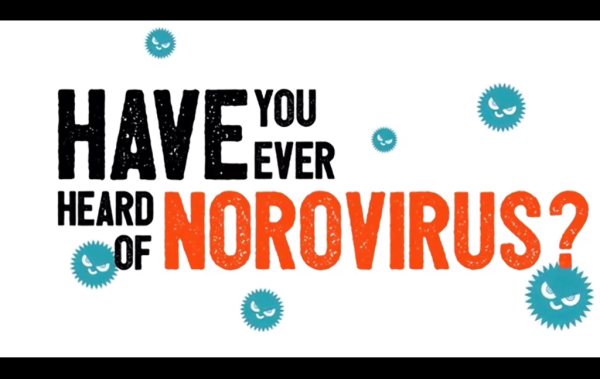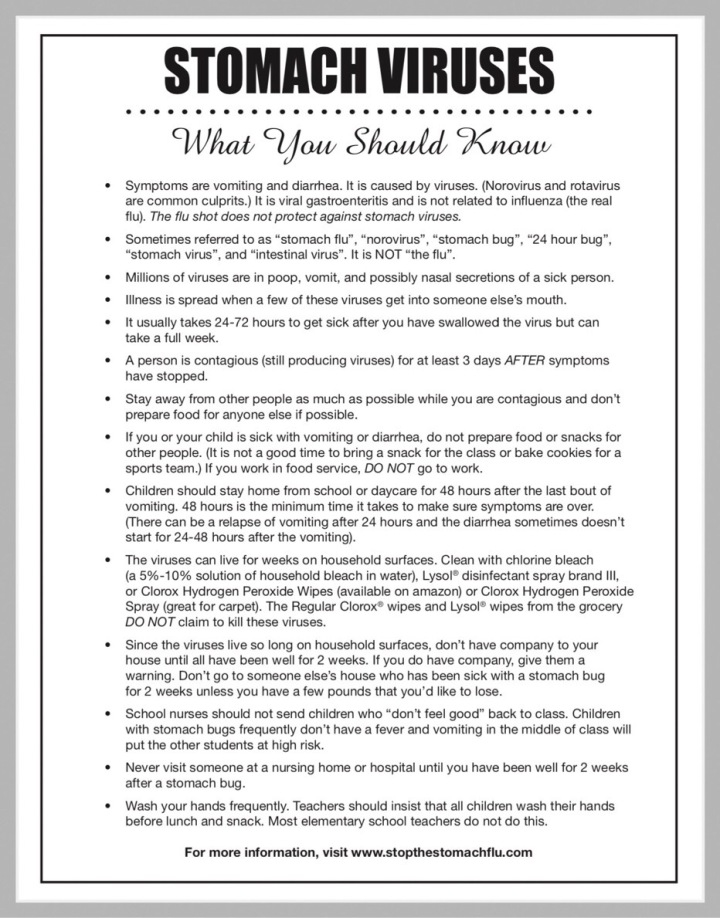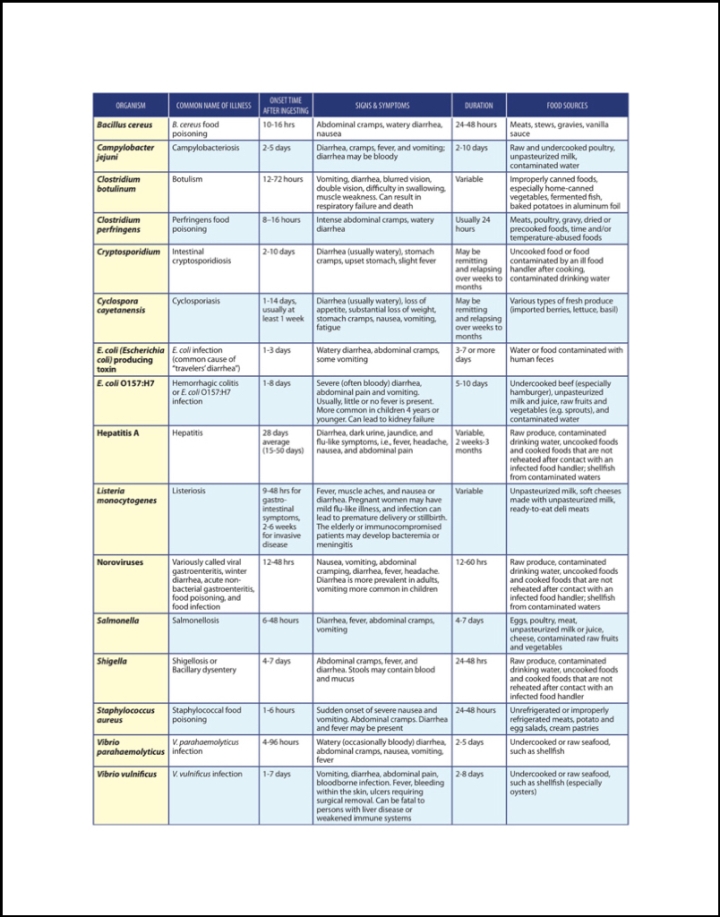What is the Norovirus?
Prologue
A recent encounter with Norovirus brought about from dining at a restaurant that doesn’t use table linens was the impetus for writing this post. I’d never heard of Norovirus before! It also turns out that the Norovirus is the main cause of most illnesses with severe gastrointestinal symptoms…who knew? The Center for Diseases and Control has a great video explaining what the Norovirus is. Norovirus is also called ‘the Winter Vomitting Bug.’ I’d never heard that expression either. You can learn more about why it’s called that at the WebMD’s website.
Food Poisoning, Flu & Colds Redefined!
Introduction
My most recent encounter began as many illnesses do with me wondering if I was coming down with something. But my time spent wondering as I lie in bed during the early morning hours didn’t last long…10 minutes later I had my answer…at least to that first question.
More questions immediately followed. I’ve only had a few instances in my life where I was overtaken by a ‘bug’ so virulent that it was unclear to me if it was food poisoning or the flu…today was one of those days. If I’m wasn’t spending time worshipping the porcelain god…I was either sleeping or trying to figure out if I was contagious. Which of course is always the main reason for determining whether or not one has food poisoning or the stomach flu.
My assumption was this: if I had food poisoning I wasn’t contagious…if it was the flu however, I was.
It Turns Out the Answer to that Question Wasn’t A Simple One
Initially I was encouraged to find a website that clearly stated known symptoms of each. I thought that all I had to do was compare symptoms, side-by-side, and then rule out the least likely candidate. I was so convinced I was onto something that I even made the chart below which would better allow me to make that comparison (because the article listed their symptoms in different orders, making a side-by-side comparison difficult.)
 My biggest problem using this approach was that there’s a huge amount of overlap in symptoms. My other big problem was that the time of onset for me had been around 12 hours (I thought.) Neither column really supported that answer.
My biggest problem using this approach was that there’s a huge amount of overlap in symptoms. My other big problem was that the time of onset for me had been around 12 hours (I thought.) Neither column really supported that answer.
You see, 12 hours prior to my awakening and feeling like I might die, we had enjoyed a nice dinner at a popular local restaurant. The restaurant, which I’m on the fence about naming, is one that we’d never been able to procure a reservation at before. Our food was excellent! The only red flag was that the restaurant appeared to me to be rather lax regarding matters of hygiene. The reason I say this was because I was surprised when the waitress tossed our silverware right onto the table…which is a big ‘no no’ in the restaurant world.
It turns out that there’s a good reason why restaurants use table linens. A reason that goes beyond that of providing atmosphere. That reason is hygiene or sanitation. The best way to prevent patrons from acquiring the germs of past table guests or even food served previously on those tables, is by providing fresh table linens or placemats…or at a minimum by placing silverware unto a fresh napkin. Because I was shocked to learn that restaurant tabletops are second only to menus in the number of germs they harbor. That alarming fact along with several other surprising ones are revealed in this 2014 Huffington Post article. But the statistic that surprised me the most was the finding that 60% of food preparation workers report for work when they are sick! The importance of that finding can’t be overstated for reasons better explained below.
Surprise #1: I learned that there is no such thing as the Stomach Flu! It’s a Myth!
The reason that the Stomach Flu doesn’t really exist is entirely because of semantics. The word ‘Flu’ is really short for influenza. But the only kind of influenza that exists which impacts people is respiratory influenza. There is no such thing as a stomach influenza with the symptoms that we normally attribute to it. When I made this realization I remembered an old adage I used to use to identify a cold from respiratory flu. The way you can tell them apart is the presence of a fever. If fever is present, it’s influenza…if not, it’s a cold.
Now that we understand that there is no such thing as the stomach flu we need to figure out what there really is. What takes the place of what we’ve called Stomach Flu for so many years?
What we’ve come to think of as the Stomach Flu is really a group of similar conditions which fall under a category that the CDC refers to as infections of the digestive system. The CDC has identified 31 known pathogens from food borne sources that comprise this category.
Surprise #2: Of the viruses, only the common cold is reported more often than a Norovirus infection—also referred to as viral gastroenteritis.
The most frequently occurring pathogen is the Norovirus. In fact, Norovirus is so prevalent that…
The first article I read about Norovirus said that it was this virus which most people erroneously referred to as the stomach flu. Because Norovirus is a virus, that led my conclusion that my symptoms fall under the category of illness…as opposed to Food Poisoning. The reason? After all my research I’m pretty certain that Norovirus was what I have, but further reading only caused me to become more confused!
Factors Leading to Even More Confusion
Although Norovirus is the most prevalent of those 31 foodborne pathogens…it isn’t alone in the symptoms it exhibits. In all, those 31 pathogens fall into 3 main categories: bacteria, parasites and viruses. Below is the CDC’s Chart (called Table 2 in their report) giving more information for all 31 pathogens (here’s a link to the CDC’s chart since my repeated efforts to splice together a readable copy haven’t been successful!)
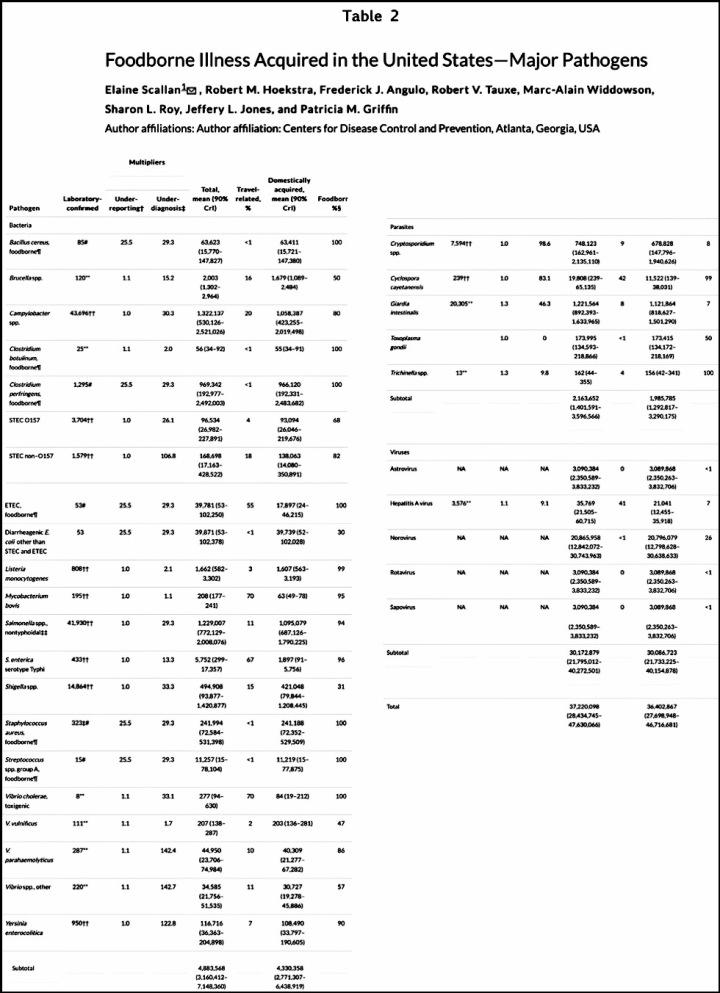
I intended to more closely examine the symptoms of each…but I never even made it that far. Because as I examined the above chart I noticed that it includes things like Salmonella and E. coli…which fall under the broad category of parasites. It was really at this point that I began getting completely confused! I’ve always believed that Salmonella and E. coli were specific types of food poisoning.
But if food poisoning is a separate malady from viral gastroenteritis (formerly known as the Stomach Flu) why do known food poisoning pathogens appear on this list at all?
It was this Medical News Today article in which I first learned about the Norovirus. In talking about viral gastroenteritis the article states that:
- Most cases of gastroenteritis are caused by infection with bacteria, viruses, or parasites
- Diarrhea, nausea, vomiting, and abdominal pain are typical symptoms of gastroenteritis
- Gastroenteritis is usually self-limiting, and tests are not usually necessary for a diagnosis
- The most serious complication of food poisoning and gastroenteritis is dehydration, especially for vulnerable people such as the very young and very old
It’s beginning to sound to me like barring a stool sample test, there is no good way to differentiate between food poisoning and a virus based illness. Yet, contagiousness is still the most worrisome factor for me!
This same article also states that:
The viruses that are most commonly implicated in gastroenteritis are:
- Rotavirus – more common in children and the most common cause of viral gastroenteritis in children
- Norovirus – more common in adults
The bacteria that are most commonly implicated in gastroenteritis are:
- Salmonella
- Campylobacter
- Shigella
- Escherichia coli (especially serotype O157:H7)
- Clostridium difficile
After a lot more reading I finally began to realize that my main premise…that Food Poisoning isn’t contagious was actually completely wrong!
What Factors Really Determine Whether or Not Food Poisoning or Gastroenteritis is Contagious
Contagiousness it appears, is determined purely by the pathogen type. Viral pathogens lead to contagious illnesses. Bacterial pathogens do not. So if you refer back to the CDC’s large table 2 (shown and linked to) above…those pathogens in the top category are bacterial…therefore they won’t lead to contagious illnesses. Those in the 2nd main category, parasites, also will lead to noncontagious illnesses. It’s only the 3rd category…the viral pathogens, which will lead to contagious illnesses. The main pathogen here is of course the Norovirus…which is what, after all my reading I concluded was responsible for my symptoms.
A Little More About the Norovirus
In addition to that large study the CDC conducted in 2011, they also publish a lot of great information for the general public. This link is to their main website for the general public describing what the Norovirus is and what you need to know about it. There’s also a helpful video explaining the Norovirus. A few important things everyone should know about the Norovirus include:
Humans are the only host of norovirus, and norovirus has several mechanisms that allow it to spread quickly and easily.
Norovirus was originally called: Norwalk-like virus or simply NLV
The first NLV outbreak occurred in 1968 among school children in Norwalk, Ohio. The prototype strain responsible for that 1968 outbreak was identified four years later, in 1972. It was the first virus identified that specifically caused gastroenteritis in humans. Albert Z. Kapikian, M.D., a pioneering virologist at the National Institutes of Health was the man who discovered the norovirus and he led a decades-long effort that resulted in the first licensed rotavirus vaccine. People infected with the Norovirus are contagious from the moment that they begin feeling ill until roughly 3 days after their symptoms have subsided. It takes minuscule amounts of the virus…less than 100 particles, to make you sick. Cruise ships and restaurants are two of the most common places to be infected with the virus. The virus can survive some disinfectants, making it hard to kill and can also remain infectious on some hard surfaces like countertops or restaurant tabletops for weeks. Last, the Norovirus is the leading cause of food poisoning!
Norovirus is Food Poisoning…here are a few good reasons to avoid it!
It might not be obvious if you’ve managed to read this far that Norovirus is indeed Food Poisoning! It wasn’t all that clear to me either…which is exactly the reason that I’m writing this post! But there’s more to the story. I for one want to know how long I can expect to be sick and more importantly how long I have to keep disinfecting everything I touch so my husband doesn’t get this too.
In a nutshell Norovirus usually lasts 2-3 days…which makes sense because I’m almost at the end of day 3 and although I’ve been feeling better I still haven’t been able to eat anything. Tonight I ate some toast (that my husband made for me so I wouldn’t germ up the kitchen) which after 15 minutes of discomfort seems to have agreed with me…yay! That alone should go a long way towards making me better…at least with the dizziness right?
I’ve read on multiple sites that I’ll continue to be contagious for 3 days after I’m feeling better…which means since it’s Tuesday night now I should be noncontagious by Friday night…geez! That alone is a really good reason to not want food poisoning! One blogger who writes for the New York Times wrote a compelling post about the contagious aspects of the virus too…probably when she was too sick to do anything else either!
Perhaps a few more questions will be answered by this table created by Canada’s version of the FDA:
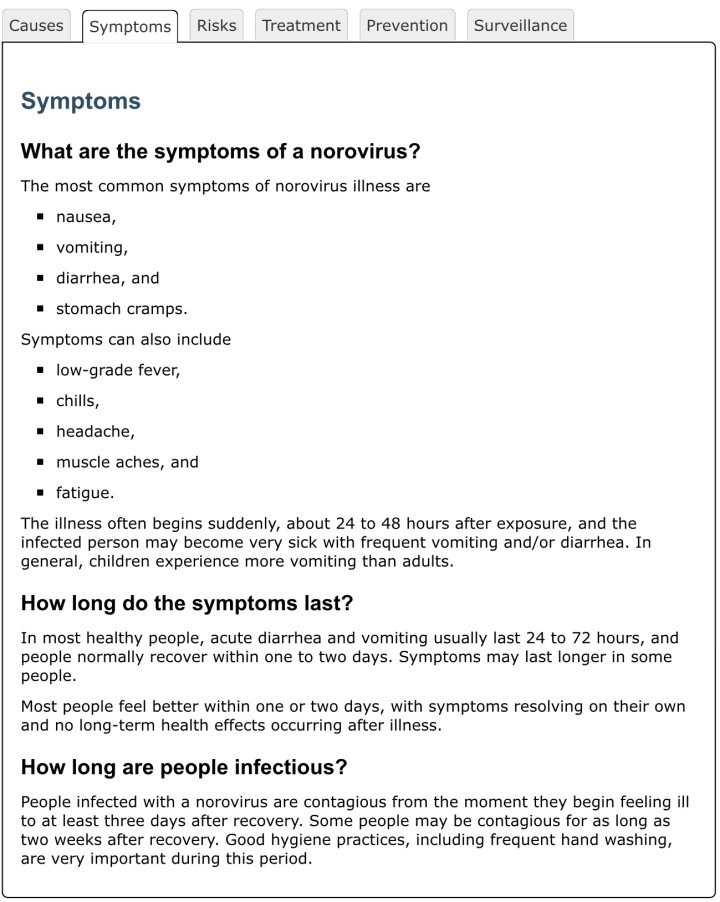
Norovirus Diagnosis
Now that I’ve successfully diagnosed my illness as Norovirus the only thing left for me to do is to reexamine how I might have contracted it and hopefully determine once and for all how contagious I might be.
What Is the Stomach Flu?
I’m adding this section about 6 months later because many family members came down with the flu that the 2016-2017 flu shot was targeting. How do I know for sure? Because my Dad’s doctor used a test kit to determine if he had it and if it was Type A which apparently the more severe form, or Type B. Although she did tell him that the test was only 40% effective in differentiating between the two. But knowing that he had it at all was important in order for her to prescribe antibiotics and an anti-viral medication…which worked because he got better much faster than other family members. But conversations during everyone’s illnesses made me realize many family members till don’t recognize that:
Flu…or influenza is really upper respiratory…and not gastrointestinal at all!
So, what we’ve always called a cold may really be the flu. One easy way to differentiate I’ve always used is this. If a fever accompanies a cold…then it’s not a cold, it’s the flu.
Most of this post has talked about Norovirus but it bears repeating in this section that what we’ve always believed to be the flu is probably really Norovirus or Rotavirus.
A Great Website: stopthestomachflu.com
I ran across a great website while getting ready for a recent trip and looking for disinfecting wipes that would kill Norovirus…because it turns out, that regular ones don’t! The website, created by a stay at home young Mom who’s a microbiologist is called stopthestomachflu.com. Her website is awesome because she conducts all sorts of experiments and tests to determine the effective of various products in removing germs. Below is a great guide from her site.
Investigating the Circumstances Leading to My Food Poisoning
As previously mentioned, the restaurant we dined at doesn’t use table coverings of any kind. Placemats I now know are intended primarily to protect patrons from foodborn pathogens. While this isn’t entirely unheard of given the new ‘farm to table‘ trend, there is one practice that can go a long way towards mitigating a lot of problems. Wait staff can be instructed to place patrons silverware onto something else. Think of that ‘something’ as a protective barrier between the utensils which come in contact with you and the seemingly hazardous tabletop environment! Something like a napkin or bread and butter plate.
Another practice which would help a lot is to use a bleach based compound when cleaning table surfaces in preparation for their next customers. Since the Norovirus is resistant to many disinfectants, adding bleach to the mix ensures that it’s germs are addressed. Although I suspect that the odor that bleach dispels might not be all that conducive to a fine dining atmosphere…which leads me to suggest to the restaurant in question this idea. That they use a multi-pronged approach. First provide a second napkin solely for the purpose of laying silverware upon, and second consider using placements.
Granted placemats don’t emanate that farm table vibe but there’s a fine line between maintaining a unique atmosphere for your customers and harming them!
To help you with that endeavor I was able to find some cute paper placemats which might work.

The placemats above are from a website called Hester and Cook. Each set is really a tablet of tear-off placemats that run from $.66 to $1 each.
Etsy has a lot of great options. One is a shop called Harper and Daisy that will custom make placemats from kraft paper like those below. Most are $36 for 50.

But was the lack of a protective table covering the only factor that led to my becoming profoundly ill?
I suppose it’s possible given my new realization that tabletop surfaces are 2nd only to menus in terms of the high number of germs they harbor. That possibility is even more likely since many of the ingredients of this restaurant’s most popular dishes are known sources of foodborne pathogens. Ingredients like duck liver, wild mushrooms, soft cheeses, lettuce, oysters and even butter immediately come to mind!
One likely scenario would be that a duck liver dish (for example) was served earlier in the evening or even in the days preceding our visit, and some remnants of it remained on the tabletop surface, which, while not visible to the human eye, contained enough germs (remember only 100 particles is necessary) to infect, my silverware.
Yet, for some inexplicable reason I feel that there’s more to this story. So let’s examine in detail what we each ordered:
In an unusual turn of events Bill and I each ordered the exact same dishes. We both ordered 2 starters (because we were attending a play at the Rep…The Foreigner…afterwards and didn’t want to be late.) For those of you who’ve never heard of this great comedy written by Milwaukee’s own Larry Shue, it’s one of my all time favorites! This was to be our third time experiencing what’s come to be known as one of the 2 greatest plays ever written by Shue…the other The Nerd is also a fabulous comedy!
The starters we ordered were:
- Grilled Herb Flat Bread, Burrata, Cranberry Agrodolce, Lettuce, Smoked Almond
- Pumpkin Soup, Oyster Mushroom, Creme Fraiche, Black Trumpet Mushroom, Chive
Many of the ingredients in both dishes could have been culprits! In addition, we also shared a bread basket and a dinner salad… the salad included these ingredients…Mixed Greens, Finocchiona, Greenfields Cheese, Apple, Almond, Pickled Pepper
Bill had a beer: New Glarus Moon Man, Pale Ale, New Glarus WI
I had a glass of wine: Pinot Noir, Bishops Peak 2014, San Luis Obispo Country, California
Since we ordered the exact same dishes it’s hard to imagine that one of those would have been responsible for my condition. But after I became very ill I discovered that Bill had never touched the salad that we’d intended upon sharing! So the salad is where I’ll focus my examination.
Here again are the salad’s ingredients:
Mixed Greens, Finocchiona, Greenfields Cheese, Apple, Almond, Pickled Pepper
The mixed greens appear to be a likely culprit. I learned that lettuce is a common carrier of food pathogens. The only way to insure that lettuce doesn’t transmit infectious germs is by proper washing. This requires only water, but washing each lettuce leaf is important. Lettuce greens can become contaminated with E. Coli, Listeria and Salmonella. Surprisingly even a Staph infection may be present if the greens are prepared by someone who’s sick (remember earlier when I discovered that 60% of food workers still go to work even if they’re sick!) Staph infection can also be transmitted by someone preparing food with an open wound on their hands or even if they have a nose or eye infection.
Here’s helpful 3 minute video created by the FDA which shows you everything you need to know about the safe handling of fresh fruits and vegetables…and even what not to buy!
At this point I’m really quite exhausted thinking about all the possibilities…and I’m kind of amazed that I’ve managed to dodge such harrowing consequences for so long…because we like to eat out a lot!
The fact that I’m still feeling the effects of whatever infected me 2 1/2 days later points even more adamantly to Norovirus. I’ve eaten nothing for 21/2 days, have no energy and get dizzy every time I stand up (although I’m clearheaded enough to realize this may be in large part because I’ve eaten nothing in days!) The dizziness could be due to dehydration but my husband made sure I didn’t become dehydrated by getting me Pedialyte.
Right now I really think this thing just needs to run its course. But I really hope that the next time I’m at a restaurant if I happen to clean off my hands using antibacterial wipes after handling the menu, or if I wipe off the salt and pepper shakers or some other frequently handled utensil that others don’t judge me too harshly. Because I wouldn’t wish this upon anyone else and if something as simple as using those would prevent how I’m feeling right now…well…would you really chose to judge me?
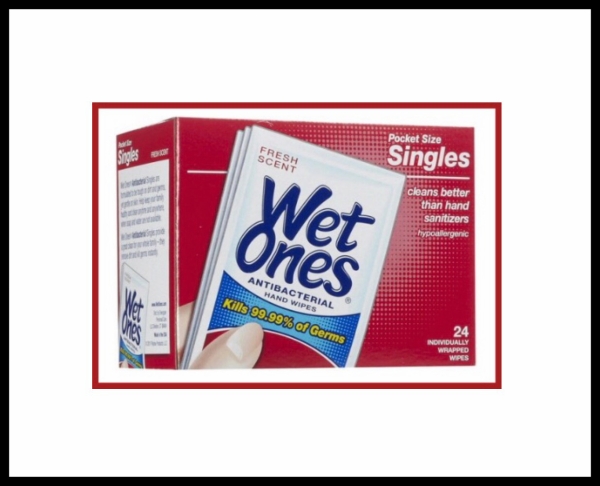
Further Reading
When the ‘5-Second Rule’ Works
Link to the FDA’s Foodborne Illness Causing Organisms in the United States: What You Need to Know
Medical News Today’s 5 Home Remedies
Below is another good Foodborne Pathogen Chart…this one was created by the FDA:


